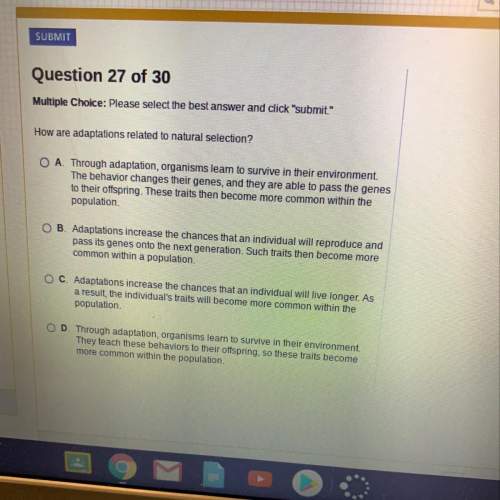
Biology, 20.11.2020 05:10 andyromero
The scientific method is a process that many scientists use to prove or disprove natural phenomena. It starts with scientific inquiry or questions that arise from an observation. For this project, observe your natural environment, and come up with a question that you would like to test using the scientific method. Remember, the scientific method is limited or restricted to investigating those physical phenomena that are:
observable;
measurable;
repeatable;
falsifiable.
You don't actually have to conduct the experiment, but you will have to explain the steps of how you would set it up and conduct it. Here is a summary of the steps of the scientific method that you must address:
Define the problem. Look around your house or outside. Is there anything that you're wondering about or have questions about? For instance, do you have any animals in the home? Maybe you have a hamster and wonder if it is more active in the day or at night. If you go outside, look at birds or insects. Maybe you wonder if ants have a food preference. Your question doesn't have to involve live organisms. Maybe you wonder what type of material best blocks out the Sun or if your sense of sight or smell affects how food tastes. Think of a question you want answered and state it in the first box below.
Research the problem. Get on the Internet or go to your local library and conduct some research on your topic. For example, what does the research say about the activity of a hamster or the food preference of ants? Or what does the research say about materials that are used to block out the sun. Or what are the effects of sight or smell on our taste buds? For whatever problem you proposed, find some information on it to help you make an educated guess or hypothesis.
Construct a hypothesis. Formulate your hypothesis based on your research. What do you think the answer to your question is? State your hypothesis in an "if-then" format. For example, your hypothesis could be "If my hamster is placed in the maze in the morning, then it will finish the maze quicker than at it would finish it at night." State your hypothesis statement in the second box below.
Design and conduct an experiment. Describe how you will set up your experiment and test your hypothesis in the third box below. You should state the materials that you will need and the measurements that you will make. Keep in mind the control group and experimental group, or any controlled or independent variables, if they apply.
Collect data. How will you set-up your data spreadsheet? What type of data will you record? Maybe you will record the amount of time the hamster takes to complete the maze in the morning versus at night. You may want to repeat the experiment to verify results. Include your data collection method in the third box below.
Draw conclusions. After reviewing your data, what are your results? Was your hypothesis correct or incorrect? If you did not actually conduct the experiment, describe the hypothetical results and the conclusion that can be drawn from those results. If your conclusion doesn't support your hypothesis, how would you change your hypothesis or experiment in the future? Discuss your conclusion in the fourth box below.

Answers: 3
Another question on Biology

Biology, 21.06.2019 22:00
Explain why phospholipid molecules form a bilayer. (3 marks)
Answers: 1

Biology, 22.06.2019 05:30
Select the word from the list that best fits the definition a system made of 25 satellites
Answers: 3


Biology, 22.06.2019 16:00
Which of the following are responsible for sending messages from the hypothalamus to the thalamus?
Answers: 1
You know the right answer?
The scientific method is a process that many scientists use to prove or disprove natural phenomena....
Questions

Mathematics, 27.05.2021 01:50

Mathematics, 27.05.2021 01:50


Arts, 27.05.2021 01:50

Mathematics, 27.05.2021 01:50



Mathematics, 27.05.2021 01:50

History, 27.05.2021 01:50

Mathematics, 27.05.2021 01:50

Mathematics, 27.05.2021 01:50




Mathematics, 27.05.2021 01:50

Chemistry, 27.05.2021 01:50

Mathematics, 27.05.2021 01:50



Mathematics, 27.05.2021 01:50




